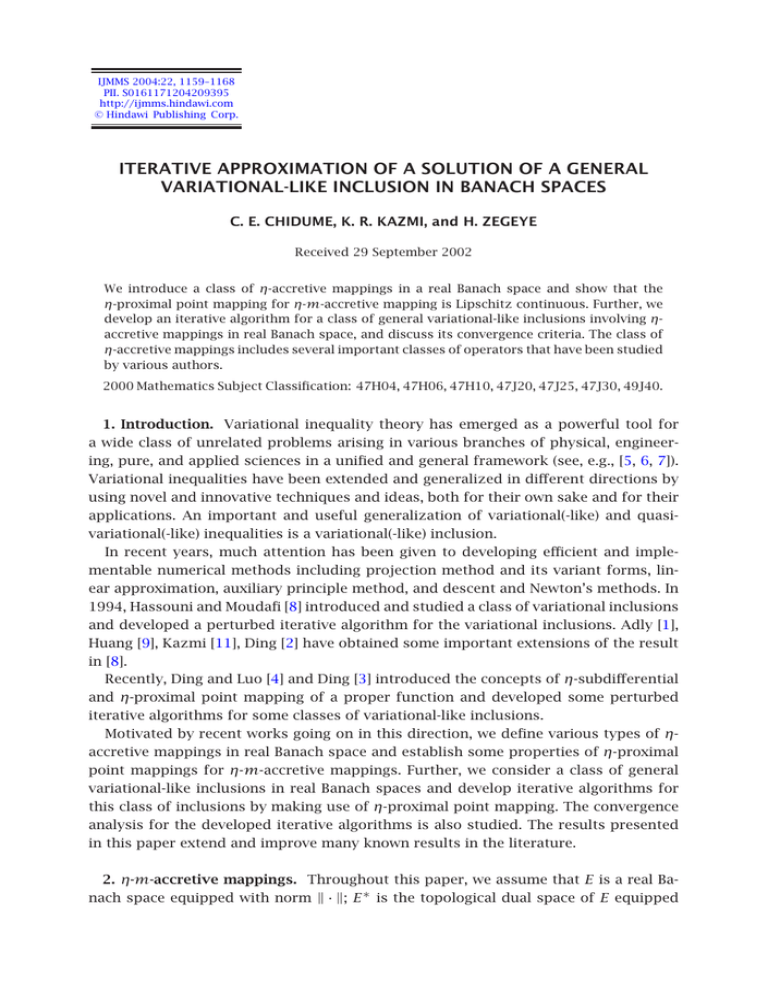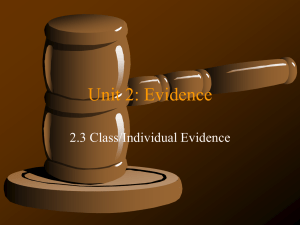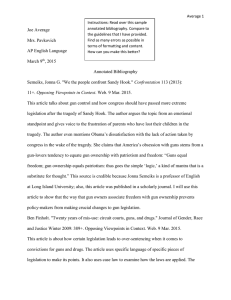ITERATIVE APPROXIMATION OF A SOLUTION OF A GENERAL
advertisement

IJMMS 2004:22, 1159–1168
PII. S0161171204209395
http://ijmms.hindawi.com
© Hindawi Publishing Corp.
ITERATIVE APPROXIMATION OF A SOLUTION OF A GENERAL
VARIATIONAL-LIKE INCLUSION IN BANACH SPACES
C. E. CHIDUME, K. R. KAZMI, and H. ZEGEYE
Received 29 September 2002
We introduce a class of η-accretive mappings in a real Banach space and show that the
η-proximal point mapping for η-m-accretive mapping is Lipschitz continuous. Further, we
develop an iterative algorithm for a class of general variational-like inclusions involving ηaccretive mappings in real Banach space, and discuss its convergence criteria. The class of
η-accretive mappings includes several important classes of operators that have been studied
by various authors.
2000 Mathematics Subject Classification: 47H04, 47H06, 47H10, 47J20, 47J25, 47J30, 49J40.
1. Introduction. Variational inequality theory has emerged as a powerful tool for
a wide class of unrelated problems arising in various branches of physical, engineering, pure, and applied sciences in a unified and general framework (see, e.g., [5, 6, 7]).
Variational inequalities have been extended and generalized in different directions by
using novel and innovative techniques and ideas, both for their own sake and for their
applications. An important and useful generalization of variational(-like) and quasivariational(-like) inequalities is a variational(-like) inclusion.
In recent years, much attention has been given to developing efficient and implementable numerical methods including projection method and its variant forms, linear approximation, auxiliary principle method, and descent and Newton’s methods. In
1994, Hassouni and Moudafi [8] introduced and studied a class of variational inclusions
and developed a perturbed iterative algorithm for the variational inclusions. Adly [1],
Huang [9], Kazmi [11], Ding [2] have obtained some important extensions of the result
in [8].
Recently, Ding and Luo [4] and Ding [3] introduced the concepts of η-subdifferential
and η-proximal point mapping of a proper function and developed some perturbed
iterative algorithms for some classes of variational-like inclusions.
Motivated by recent works going on in this direction, we define various types of ηaccretive mappings in real Banach space and establish some properties of η-proximal
point mappings for η-m-accretive mappings. Further, we consider a class of general
variational-like inclusions in real Banach spaces and develop iterative algorithms for
this class of inclusions by making use of η-proximal point mapping. The convergence
analysis for the developed iterative algorithms is also studied. The results presented
in this paper extend and improve many known results in the literature.
2. η-m-accretive mappings. Throughout this paper, we assume that E is a real Banach space equipped with norm · ; E ∗ is the topological dual space of E equipped
1160
C. E. CHIDUME ET AL.
with norm | · |; CB(E) is the family of all nonempty closed and bounded subsets of
E; 2E is a power set of E; H(·, ·) is the Hausdorff metric on CB(E) defined by
H(A, B) = max
sup inf d(x, y), sup inf d(x, y) ;
x∈A y∈B
y∈B x∈A
(2.1)
∗
·, · is the dual pair between E and E ∗ , and J : E → 2E is the normalized duality mapping defined by
J(x) = f ∈ E ∗ : x, f = x2 , x = f ,
x ∈ E.
(2.2)
We observe immediately that if E = H, a Hilbert space, then J is the identity map on H.
First, we introduce the following definitions.
Definition 2.1. A mapping η : E × E → E is said to be
(i) accretive, if there exists jη(u, v) ∈ J(η(u, v)) such that
u − v, jη(u, v) ≥ 0,
∀u, v ∈ E;
(2.3)
(ii) strictly accretive, if there exists jη(u, v) ∈ J(η(u, v)) such that
u − v, jη(u, v) ≥ 0,
∀u, v ∈ E,
(2.4)
and equality holds if and only if u = v;
(iii) δ-strongly accretive, if there exist jη(u, v) ∈ J(η(u, v)) and δ > 0 such that
u − v, jη(u, v) ≥ δu − v2 ,
∀u, v ∈ E;
(2.5)
(iv) τ-Lipschitz continuous, if there exist jη(u, v) ∈ J(η(u, v)) and τ > 0 such that
jη(u, v) ≤ τu − v,
∀u, v ∈ E.
(2.6)
Definition 2.2. Let η : E × E → E be a single-valued mapping. Then a multivalued
mapping M : E → 2E is said to be
(i) η-accretive, if there exists jη(u, v) ∈ J(η(u, v)) such that
x − y, jη(u, v) ≥ 0,
∀u, v ∈ E, ∀x ∈ Mu, y ∈ Mv;
(2.7)
(ii) strictly η-accretive, if there exists jη(u, v) ∈ J(η(u, v)) such that
x − y, jη(u, v) ≥ 0,
∀u, v ∈ E, ∀x ∈ Mu, y ∈ Mv,
(2.8)
and equality holds if and only if u = v;
(iii) γ-strongly η-accretive, if there exist jη(u, v) ∈ J(η(u, v)) and γ > 0 such that
x − y, jη(u, v) ≥ γu − v2 ,
∀u, v ∈ E, ∀x ∈ Mu, y ∈ Mv;
(2.9)
(iv) η-m-accretive, if M is η-accretive and (I + ρM)(E) = E for any ρ > 0, where I
stands for identity mapping.
APPROXIMATION OF A SOLUTION OF A GENERAL VARIATIONAL-LIKE . . .
1161
Remark 2.3. In Definition 2.2, if η(u, v) = u − v, for all u, v ∈ E, we recover the
usual definitions of accretiveness of the multivalued mapping E.
Definition 2.4. A multivalued mapping M : E → 2E is said to be α-H-Lipschitz continuous, if there exists α > 0 such that
H(Mu, Mv) ≤ αu − v,
∀u, v ∈ E.
(2.10)
We need the following lemma in the sequel.
∗
Lemma 2.5 [13]. Let E be a real Banach space and J : E → 2E the normalized duality
mapping. Then for any x, y ∈ E,
x + y2 ≤ x2 + 2 y, j(x + y) ,
∀j(x + y) ∈ J(x + y).
(2.11)
Now, we prove the following lemmas.
Lemma 2.6. Let η : E × E → E be a strictly accretive mapping and let M : E → 2E be
η-m-accretive multivalued mapping. Then
(a) x − y, jη(u, v) ≥ 0, for all (y, v) ∈ Graph(M), implies (x, u) ∈ Graph(M),
where Graph(M) := {(x, u) ∈ E × E : x ∈ Mu};
(b) the mapping (I + ρM)−1 is single-valued for all ρ > 0.
Proof. (a) Suppose, on the contrary, that there exists (x0 , u0 ) ∈ Graph(M) such that
x0 − y, jη u0 , v ≥ 0,
∀(y, v) ∈ Graph(M).
(2.12)
Since M is η-m-accretive, we have (I + ρM)(E) = E, and hence there exists (x1 , u1 ) ∈
Graph(M) such that
x1 + ρu1 = x0 + ρu0 .
(2.13)
Now, first set (y, v) = (x1 , u1 ) in (2.12), and then, from the resultant inequality and
(2.13), we obtain
0 ≤ x0 − x1 , jη u0 , u1 = ρ u1 − u0 , jη u0 , u1 ,
(2.14)
which implies that
ρ u0 − u1 , jη u0 , u1 ≤ 0,
since ρ > 0.
(2.15)
But η is strictly accretive, so we have
0 ≤ u0 − u1 , jη u0 , u1 ≤ 0,
(2.16)
which yields u0 = u1 , and hence, from (2.13), we get x1 = x0 , a contradiction. This
completes the proof of (a).
1162
C. E. CHIDUME ET AL.
(b) For any given z ∈ E and a constant ρ > 0, let u, v ∈ (I + ρM)−1 (z). Then ρ −1 (z −
u) ∈ Mu and ρ −1 (z − v) ∈ Mv. Now,
0 = ρ ρ −1 (z − u) − ρ −1 (z − v), jη(u, v) + u − v, jη(u, v)
≥ u − v, jη(u, v) ,
(2.17)
using η-accretiveness of M. Since η is strictly accretive, from the above inequality, we
have u = v. This implies that (I + ρM)−1 is single valued. This completes the proof.
Remark 2.7. By Lemma 2.6, we can define η-proximal point mapping for an η-maccretive mapping M as follows:
JρM (z) = (I + ρM)−1 (z),
∀z ∈ E,
(2.18)
where ρ > 0 is a constant and η : E × E → E is a strictly accretive mapping.
Lemma 2.8. Let η : E × E → E be a δ-strongly accretive and τ-Lipschitz continuous
mapping and let M : E → 2E be an η-m-accretive mapping. Then the η-proximal point
mapping JρM is τ/δ-Lipschitz continuous, that is,
M
J (u) − J M (v) ≤ τ u − v,
ρ
ρ
δ
∀u, v ∈ E.
(2.19)
Proof. Let u, v ∈ E. From the definition of JρM , we have JρM (u) = (I + ρM)−1 (u).
This implies that
ρ −1 u − JρM (u) ∈ M JρM (u) .
(2.20)
ρ −1 v − JρM (v) ∈ M JρM (v) .
(2.21)
Similarly, we have
Since M is η-accretive, we obtain
u − JρM (u) − v − JρM (v) , jη JρM (u), JρM (v)
= ρ −1 u − v, jη JρM (u), JρM (v) − ρ −1 JρM (u) − JρM (v), jη JρM (u), JρM (v) .
0 ≤ ρ −1
(2.22)
Since ρ > 0, and η is δ-strongly accretive and τ-Lipschitz continuous, from the above
inequality, we have
2
δJρM (u) − JρM (v) ≤ τu − v · JρM (u) − JρM (v).
(2.23)
This implies that
M
J (u) − J M (v) ≤ τ u − v,
ρ
ρ
δ
and this completes the proof.
∀u, v ∈ E,
(2.24)
APPROXIMATION OF A SOLUTION OF A GENERAL VARIATIONAL-LIKE . . .
1163
3. General variational-like inclusions and iterative algorithm. Let η, N : E × E → E
and G : E → E be three single-valued mappings, let S, T : E → CB(E) be two multivalued
mappings, and let M : E × E → 2E be a multivalued mapping such that, for each u ∈ E,
M(·, u) is η-m-accretive. We consider the following general variational-like inclusion
problem (in short, GVIP).
Find u ∈ E, x ∈ Su, and y ∈ T u such that
0 ∈ N(x, y) + M(Gu, u).
(3.1)
The following are special cases of GVIP (3.1).
(I) If E = H, a real Hilbert space, M(·, u) = ∂φ(·, u), where φ : H × H → R {+∞} is
such that φ(·, u) is a proper and lower semicontinuous functional for all u ∈ H, and
∂φ(·, u) denotes the η-subdifferential of φ(·, u), then GVIP (3.1) reduces to variationallike inequality problem of finding u ∈ H, x ∈ Su, and y ∈ T u, such that
N(x, y), η(v, Gu) ≥ φ(Gu, u) − φ(Gu, v),
∀v ∈ H,
(3.2)
similar to the problem considered by Ding [3].
(II) In inequality (3.2), if N(x, y) = x − y, for all x, y ∈ H, and if S and T are singlevalued mappings, still in Hilbert spaces, then problem (3.2) reduces to variational-like
inequality problem considered by Ding and Luo [4].
We remark that for suitable choices of N, η, M, S, T , and G, GVIP (3.1) reduces to
various classes of variational inclusions and variational inequalities (e.g., [2, 8, 9, 11])
studied by various authors in Hilbert spaces. Our problem (3.1) is also set in more
general real Banach spaces.
The following lemma, which will be used in the sequel, is an immediate consequence
M(·,u)
.
of the definition of Jρ
Lemma 3.1. For given u ∈ E, x ∈ Su, and y ∈ T u, (u, x, y) is a solution of GVIP (3.1)
if and only if it is a solution of
Gu = JρM(·,u) Gu − ρN(x, y) ,
M(·,u)
where Jρ
(3.3)
= (I + ρM(·, u))−1 and ρ > 0 is a constant.
Using Lemma 3.1 and a theorem of Nadler [12], we develop an iterative algorithm for
finding the approximate solution of GVIP (3.1) as follows.
Iterative algorithm 3.2. Let η, N : E × E → E, G : E → E, and S, T : E → CB(E) be
such that, for each u ∈ E, Q(u) ⊆ G(E), where Q : E → 2E is a multivalued mapping
defined by
Q(u) =
JρM(·,u) Gu − ρN(x, y) ,
(3.4)
x∈Su y∈T u
where M : E × E → 2E is a multivalued mapping such that, for each u ∈ E, M(·, u) is
η-m-accretive.
1164
C. E. CHIDUME ET AL.
For given u0 ∈ E, x0 ∈ Su0 , and y0 ∈ T u0 , let
Gu0 − ρN x0 , y0 ∈ Q u0 ⊆ G(E).
M(·,u0 ) w0 = Jρ
(3.5)
Hence there exists u1 ∈ E such that w0 = G(u1 ). Since x0 ∈ Su0 ∈ CB(E) and y0 ∈
T u0 ∈ CB(E), then, by Nadler’s result [12], there exist x1 ∈ Su1 and y1 ∈ T u1 such that
x0 − x1 ≤ 1 + (1 + 1)−1 H Su0 , Su1 ,
y0 − y1 ≤ 1 + (1 + 1)−1 H T u0 , T u1 .
(3.6)
Let
Gu1 − ρN x1 , y1 ∈ Q u1 ⊆ G(E).
M(·,u1 ) w1 = Jρ
(3.7)
Hence there exists u2 ∈ E such that w1 = G(u2 ). By induction, we can define iterative
sequences {un }, {Gun }, {xn }, and {yn } as follows:
Gun+1 = JρM(·,un ) Gun − ρN xn , yn ,
xn ∈ Sun : xn − xn+1 ≤ 1 + (1 + n)−1 H Sun , Sun+1 ,
yn ∈ T un : yn − yn+1 ≤ 1 + (1 + n)−1 H T un , T un+1 ,
(3.8)
(3.9)
(3.10)
where n = 0, 1, 2, 3, . . . and ρ > 0 is a constant.
4. Convergence analysis for Iterative Algorithm 3.2.
Theorem 4.1. Let E be a real Banach space and let η : E × E → E be δ-strongly accretive and τ-Lipschitz continuous. Let S, T : E → CB(E), and G : E → E be σ -H-Lipschitz
continuous, k-H-Lipschitz continuous, and ξ-Lipschitz continuous mappings, respectively,
and let G be ν-strongly η-accretive mapping. Let N : E ×E → E be α- and β-Lipschitz continuous with respect to the first and second arguments, respectively, and γ-strongly ηaccretive with respect to S in the first argument. Let M : E ×E → 2E be such that, for each
fixed w ∈ E, M(·, w) is η-m-accretive mapping, and, for each u ∈ E, let Q(u) ⊆ G(E),
where Q is defined by (3.4). Suppose that there exist ρ > 0 and λ > 0 such that, for each
w1 , w2 , v ∈ E,
M(·,w1 )
M(·,w2 )
Jρ
(v) − Jρ
(v) ≤ λw1 − w2 ,
(4.1)
2
+ τ) − νδkβ(1 − l) ρ − τ γ − σ α(ξ
τ 2 2σ 2 α2 − k2 β2
2 τ 2 γ − σ α(ξ + τ) − νδkβ(1 − l) − 2σ 2 α2 − k2 β2 τ 4 ξ 2 − ν 2 δ2 (1 − l)2
,
<
τ 2 2σ 2 α2 − k2 β2
(4.2)
2
2
2
2
2
2
4
2
2
2
2
(4.3)
τ γ > τ σ α(ξ + τ) + νδkβ(1 − l) + 2σ α − k β τ ξ − ν δ (1 − l) ,
τ 2 ξ > νδ(1 − l),
2σ α > kβ,
(4.4)
APPROXIMATION OF A SOLUTION OF A GENERAL VARIATIONAL-LIKE . . .
1165
where l = (τ/ν)λ. Then the iterative sequences {un }, {Gun }, {xn }, and {yn } generated
by Iterative Algorithm 3.2 converge strongly to u∗ , Gu∗ , x ∗ , and y ∗ , respectively, and
(u∗ , x ∗ , y ∗ ) is a solution of GVIP (3.1).
Proof. From Lemma 2.8, (3.8), and inequality (4.1), we have the following estimates:
Gun+2 − Gun+1 M(·,un+1 ) = Jρ
Gun+1 − ρN xn+1 , yn+1 − JρM(·,un ) Gun − ρN xn , yn M(·,un+1 ) M(·,un+1 ) ≤ Jρ
Gun+1 − ρN xn+1 , yn+1 − Jρ
Gun − ρN xn , yn M(·,un+1 ) Gun − ρN xn , yn − JρM(·,un ) Gun − ρN xn , yn + Jρ
τ
≤ Gun+1 − Gun − ρ N xn+1 , yn+1 − N xn , yn + λun+1 − un δ
τ
≤ Gun+1 − Gun − ρ N xn+1 , yn+1 − N xn , yn+1 δ
τ + ρ N xn , yn+1 − N xn , yn + λun+1 − un .
δ
(4.5)
Since G is ν-strongly η-accretive and η is τ-Lipschitz continuous, we have the following
estimates:
τ un+1 − un Gun+1 − Gun ≥ Gun+1 − Gun , jη un+1 , Gun
2
≥ ν un+1 − un (4.6)
implies that
un+1 − un ≤ τ Gun+1 − Gun .
ν
(4.7)
From the assumption that N is β-Lipschitz continuous in the second argument and T
is k-H-Lipschitz continuous, we get that
N xn , yn+1 − N xn , yn ≤ βyn+1 − yn ≤ βk 1 + (1 + n)−1 un+1 − un .
(4.8)
Furthermore, since N is γ-strongly η-accretive with respect to S in the first argument
and α-Lipschitz continuous with respect to the first argument and G is ξ-Lipschitz
continuous, by using Lemma 2.5, we obtain that
Gun+1 − Gun − ρ N xn+1 , yn+1 − N xn , yn+1 2
2
≤ Gun+1 − Gun − 2ρ N xn+1 , yn+1 − N xn , yn+1 ,
j Gun+1 − Gun − ρ N xn+1 , yn+1 − N xn , yn+1
2
≤ ξ 2 un+1 − un − 2ρ N xn+1 , yn+1 − N xn , yn+1 , j η un+1 , un
− 2ρ N xn+1 , yn+1
− N xn , yn+1 , j Gun+1 − Gun − ρ N xn+1 , yn+1 − N xn , yn+1
− j η un+1 , un
1166
C. E. CHIDUME ET AL.
2
2
≤ ξ 2 un+1 − un − 2ργ un+1 − un + 2ρ N xn+1 , yn+1 − N xn , yn+1 × Gun+1 − Gun + ρ N xn+1 , yn+1 − N xn , yn+1 + η un+1 , un 2
≤ ξ 2 − 2ργ un+1 −un +2ραxn+1 − xn ξ + τ un+1 − un + ραxn+1 − xn 2 = ξ 2 − 2ργ + 2ρασ (ξ + τ) 1 + (1 + n)−1 + 2ρ 2 α2 σ 2 1 + (1 + n)−1
2
× un+1 − un ,
(4.9)
where S is σ -H-Lipschitz continuous.
Combining (4.5), (4.7), (4.8), and (4.9), we have the following estimates:
un+2 − un+1 ≤ θn un+1 − un ,
(4.10)
where
θn : =
τ2
νδ
2
ξ 2 − 2ργ + 2ρασ (ξ + τ) 1 + (1 + n)−1 + 2ρ 2 α2 σ 2 1 + (1 + n)−1
τ
+ ρβk 1 + (1 + n)−1 + λ.
ν
(4.11)
Letting n → ∞, we obtain that θn → θ, where
θ :=
τ
τ2 2
ξ − 2ργ + 2ρασ (ξ + τ) + 2ρ 2 α2 σ 2 + ρβk + λ.
νδ
ν
(4.12)
It follows from (4.10), conditions (4.2)–(4.4) and (4.11), (4.12) that {un } is a Cauchy
sequence in E. So, there exists u∗ ∈ E such that un → u∗ as n → ∞. From Lipschitz
continuity of G, we have that
Gun+1 − Gun ≤ ξ un+1 − un .
(4.13)
Also, from (3.9), we get that
xn − xn+1 ≤ 1 + (1 + n)−1 H Sun , Sun+1 ≤ σ 1 + (1 + n)−1 un − un+1 .
(4.14)
Since {un } is a Cauchy sequence, it follows from (4.13) and (4.14) that {Gun } and {xn }
both are also Cauchy sequences. Similarly, {yn } is a Cauchy sequence. Hence there exist
x ∗ , y ∗ ∈ E such that Gun → Gu∗ , xn → x ∗ , and yn → y ∗ as n → ∞. Furthermore,
d x ∗ , Su∗ ≤ x ∗ − xn + d xn , Su∗
≤ x ∗ − xn + H Sun , Su∗
≤ x ∗ − xn + σ un − u∗ → 0,
and hence x ∗ ∈ Su∗ . Similarly, y ∗ ∈ T u∗ .
(4.15)
APPROXIMATION OF A SOLUTION OF A GENERAL VARIATIONAL-LIKE . . .
1167
Finally, we define
∗)
w ∗ := JρM(·,u
Gu∗ − ρN x ∗ , y ∗ .
(4.16)
Now, we estimate that
Gun+2 − w ∗ ≤ τ Gun+1 − Gu∗ − ρ N xn+1 , yn+1 − N x ∗ , y ∗ δ + λun+1 − u∗ τ Gun+1 − Gu∗ + ρ N xn+1 , yn+1 − N x ∗ , yn+1 δ
+ ρ N x ∗ , yn+1 − N x ∗ , y ∗ + λun+1 − u∗ τ Gun+1 − Gu∗ + ραxn+1 − x ∗ + ρβyn+1 − y ∗ ≤
δ + λun+1 − u∗ → 0 as n → ∞.
≤
(4.17)
Thus, by Lemma 3.1, it follows that (u∗ , x ∗ , y ∗ ) is a solution of GVIP (3.1), and this
completes the proof.
Remark 4.2. It is clear that δ ≤ τ, ν ≤ ξ, and γ ≤ α. Further, condition (4.2) is true
for suitable values of constants, for example,
(i) δ = τ = ν = ξ = γ = α = 1; σ = β = k = λ = 0.1; and ρ = 0.5;
(ii) δ = ν = γ = σ = β = k = ρ = 0.1; τ = ξ = α = 0.2; and λ = 0.01.
Remark 4.3. Most of the results in, for example, [4, 10] and the references therein,
are obtained in Hilbert spaces. Our theorems extend them to the more general real
Banach spaces considered in this paper.
Acknowledgment. The third author undertook this work when he was visiting the
Abdus Salam International Centre for Theoretical Physics, Trieste, Italy, as a postdoctoral fellow.
References
[1]
[2]
[3]
[4]
[5]
[6]
[7]
[8]
S. Adly, Perturbed algorithms and sensitivity analysis for a general class of variational
inclusions, J. Math. Anal. Appl. 201 (1996), no. 2, 609–630.
X. P. Ding, Perturbed proximal point algorithms for generalized quasivariational inclusions,
J. Math. Anal. Appl. 210 (1997), no. 1, 88–101.
, Generalized quasi-variational-like inclusions with nonconvex functionals, Appl.
Math. Comput. 122 (2001), no. 3, 267–282.
X. P. Ding and C. L. Luo, Perturbed proximal point algorithms for general quasi-variationallike inclusions, J. Comput. Appl. Math. 113 (2000), no. 1-2, 153–165.
F. Giannessi and A. Maugeri (eds.), Variational Inequalities and Network Equilibrium Problems, Plenum Press, New York, 1995.
R. Glowinski, Numerical Methods for Nonlinear Variational Problems, Springer Series in
Computational Physics, Springer-Verlag, New York, 1984.
R. Glowinski, J.-L. Lions, and R. Trémolières, Numerical Analysis of Variational Inequalities, Studies in Mathematics and Its Applications, vol. 8, North-Holland Publishing,
Amsterdam, 1981.
A. Hassouni and A. Moudafi, A perturbed algorithm for variational inclusions, J. Math. Anal.
Appl. 185 (1994), no. 3, 706–712.
1168
[9]
[10]
[11]
[12]
[13]
C. E. CHIDUME ET AL.
N.-J. Huang, Generalized nonlinear variational inclusions with noncompact valued mappings, Appl. Math. Lett. 9 (1996), no. 3, 25–29.
, A new class of generalized set-valued implicit variational inclusions in Banach spaces
with an application, Comput. Math. Appl. 41 (2001), no. 7-8, 937–943.
K. R. Kazmi, Mann and Ishikawa type perturbed iterative algorithms for generalized quasivariational inclusions, J. Math. Anal. Appl. 209 (1997), no. 2, 572–584.
S. B. Nadler Jr., Multi-valued contraction mappings, Pacific J. Math. 30 (1969), 475–488.
W. V. Petryshyn, A characterization of strict convexity of Banach spaces and other uses of
duality mappings, J. Funct. Anal. 6 (1970), 282–291.
C. E. Chidume: The Abdus Salam International Centre for Theoretical Physics, 34100 Trieste,
Italy
E-mail address: chidume@ictp.trieste.it
K. R. Kazmi: Department of Mathematics, Aligarh Muslim University, Aligarh 202 002, India
Current address: The Abdus Salam International Centre for Theoretical Physics, 34100 Trieste,
Italy
E-mail address: krkazmi0@postmark.net
H. Zegeye: The Abdus Salam International Centre for Theoretical Physics, 34100 Trieste, Italy
E-mail address: habz@ictp.trieste.it





